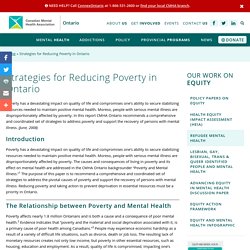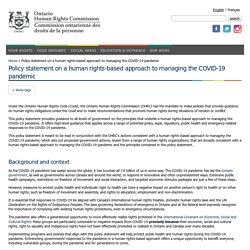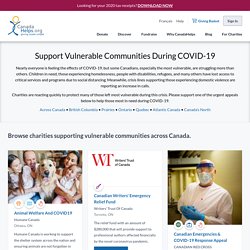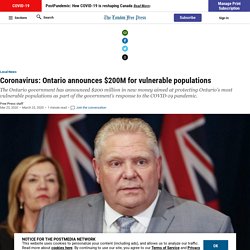

Key Health Inequalities in Canada: A National Portrait – Executive Summary. Health inequalities in Canada exist, are persistent, and in some cases, are growingFootnote 1 Footnote 2 Footnote 3.

Many of these inequalities are the result of individuals' and groups' relative social, political, and economic disadvantages. Such inequalities affect peoples' chances of achieving and maintaining good health over their lifetimes Footnote 4. Where inequalities in health outcomes or in access to the resources that support health are systematic (that is, the patterns of difference are consistently observable between population groups) and can plausibly be avoided or ameliorated by collective action, they may be deemed unjust and inequitable Footnote 5 Footnote 6 Footnote 7. This report describes the magnitude and distribution of key health inequalities in Canada, a critical step in facilitating action to advance health equity.
The Health Inequalities Reporting Initiative aims to strengthen health inequalities measurement, monitoring, and reporting capacity in Canada. What Is Elder Abuse Voices From the Margin The Views of Underrepresented Canadian Older Adults. Perspectives of HIV-positive and -negative people who use drugs regarding the criminalization of HIV non-disclosure in Canada. © Canadian Journal of Sociology-Everyday discriminationin canada: Prevalence and Patterns.
Perinatal care experiences of Muslim women in Northwestern Ontario, Canada: A qualitative study. Environmental health and vulnerable populations in Canada: mapping an integ...: Discover for Scholarly Articles. Medical Assistance in Dying (MAiD) in Canada: A Critical Analysis of the Exclusion of Vulnerable Populations. The Prevalence of Food Allergy is Less Frequent in Vulnerable Populations in Canada. Prevalence and Predictors of Food Allergy in Canada:A Focus on Vulnerable Populations. Access to Vision Services by Vulnerable Populations in Canada: A Scoping Review. Canadian Nurses Association: Three strategies to help Canada’s most vulnerable. The Royal College of Physicians and Surgeons of Canada. Cheryl Mack, MD, MA, FRCPC Learning Objectives To be able to define and identify vulnerable populations as they pertain to medical research To understand why populations within developing countries should be considered vulnerable as test populations To highlight the ethical concerns that arise specifically when engaging in medical research in developing countries To understand the safeguards that are typically implemented to decrease the incidence of exploitation To be made aware of the ongoing debate that arises when we discuss ethical universalism, ethical imperialism and ethical relativism Case ABC Pharmaceuticals has discovered what it hopes to be the next generation of antiretroviral drugs.

Improving access to primary healthcare for vulnerable populations in Australia and Canada: protocol for a mixed-method evaluation of six complex interventions. Monitoba: Vulnerable populations. Minority and vulnerable populations. Ontario Public Health: priority populations. Ontario Public Health: focus on priority populations. Public Health Ontario: planning through equity lens. Ontario Public Health: socioeconomic inequality measures. Ontario Public Health: focus on alcohol marketing. Ontario Public Health: sustainable food systems. Ontario Public Health: health equity barriers. Understanding Health Inequities and Access to Primary Care in the South WestLHIN. Ontario Marginalization Index: Frequently Asked Questions (FAQs)Ontario Marginalization Index: Frequently Asked Questions (FAQs) Protecting Vulnerable People from Health Impacts of Extreme Heat. Tobacco Retail Outlets and Vulnerable Populations in Ontario, Canada.
Community literacy in Ontario. Strategies for Reducing Poverty in Ontario. Poverty has a devastating impact on quality of life and compromises one’s ability to secure stabilizing resources needed to maintain positive mental health.

Moreso, people with serious mental illness are disproportionately affected by poverty. In this report CMHA Ontario recommends a comprehensive and coordinated set of strategies to address poverty and support the recovery of persons with mental illness. (June, 2008) Vulnerable populations and COVID-19. While COVID-19 can make anyone sick, some Canadians may be at greater risk of COVID-19 than others due to their occupational, social, economic and other health and life circumstances.

Organizations, staff and volunteers play an important role in helping to prevent these populations from getting or spreading the COVID-19 virus. Start by sharing simple things they can do to help keep themselves and others healthy, guide them to help if they develop any signs and symptoms and learn ways help care for sick clients recovering from COVID-19. Vulnerable populations may include Individuals who are at risk of more severe disease or outcomes, including: Policy statement on a human rights-based approach to managing the COVID-19 pandemic.
Under the Ontario Human Rights Code (Code), the Ontario Human Rights Commission (OHRC) has the mandate to make policies that provide guidance on human rights obligations under the Code and to make recommendations that promote human rights during situations of tension or conflict.

This policy statement provides guidance to all levels of government on the principles that underlie a human rights-based approach to managing the COVID-19 pandemic. It offers high-level guidance that applies across a range of potential policy, legal, regulatory, public health and emergency-related responses to the COVID-19 pandemic. Background and context. Support Vulnerable Communities During COVID-19. Nearly everyone is feeling the effects of COVID-19, but some Canadians, especially the most vulnerable, are struggling more than others.

Children in need, those experiencing homelessness, people with disabilities, refugees, and many others have lost access to critical services and programs due to social distancing. Meanwhile, crisis lines supporting those experiencing domestic violence are reporting an increase in calls. Charities are reacting quickly to protect many of those left most vulnerable during this crisis. Please support one of the urgent appeals below to help those most in need during COVID-19. Ontario Delivers Action Plan to Increase Protection for Vulnerable People and Those Who Care for Them.
Details of the plan were unveiled today by Premier Doug Ford, Todd Smith, Minister of Children, Community and Social Services, Christine Elliott, Deputy Premier and Minister of Health, and Dr.

Merrilee Fullerton, Minister of Long-Term Care. "The plan we are announcing today will build on and support the critical work that is currently being carried out each and every day by our frontline heroes to care for our most vulnerable citizens," said Premier Ford. Coronavirus: Ontario announces $200M for vulnerable populations. Article content The Ontario government has announced $200 million in new money aimed at protecting Ontario’s most vulnerable populations as part of the government’s response to the COVID-19 pandemic.

The money, announced Monday, will go toward supporting municipalities and organizations such as shelters, food banks and other non-profit groups so they continue to deliver services — and even hire additional staff — during the coronavirus crisis. Municipalities will decide how to distribute these funds, the province said. COVID-19 action plan: protecting vulnerable Ontarians. Vulnerable Ontarians in residential settings, and the workers caring for them, face heightened risk during the COVID-19 outbreak.

This is a source of serious concern and worry for our government, those individuals, their friends and families and the community as whole. The Ontario government is taking immediate action and building upon previous measures to better protect our most vulnerable and the frontline staff who care for them. We are working with our partners who operate these homes and facilities,including working with our partners who operate these homes and facilities municipalities, agencies and the federal government to do everything we can to ensure the safety of these vulnerable communities during COVID-19. Within 48 hours, starting with our developmental services sites, new measures will be put in place to enhance screening and testing, helping to reduce exposure to COVID-19, prevent the spread of the virus and increase infection control measures.
April 23. Stigmatization of psychiatric and justice-involved populations during the COVID-19 pandemic. COVID-19 highlights existing barriers for Canadians with communication disabilities. The COVID-19 pandemic has highlighted long-standing barriers preventing Canadians with communication disabilities from fully accessing the health-care system, according to advocates across the country who are calling for governments to address the issue.

Organizations and individuals point to recent cases in which disabled patients were denied access to crucial communication supports while in hospital, leaving them unable to interact with loved ones or medical professionals. They say the two incidents -- one of which involved the death of a 40-year-old woman -- highlight the inconsistent approach to such issues in hospitals across Canada and should prompt governments to set uniform standards to protect disabled patients. Newsletter sign-up: Get The COVID-19 Brief sent to your inbox "It terrifies me -- on an advocacy level, but also on a personal level," Janz said in an interview conducted with the support of an aide who echoed her words.
"Communication is a human right," Borden said. Health System News The Latest Research and Information on COVID-19: Social Determinants of Health. Page Content The Social Determinants of Health and the COVID-19 Pandemic This section shares some emerging research and resources on the social determinants of health as it relates to COVID-19. Race/Ethnicity/Culture Early data in the United States (U.S.) show a disproportionate number of African Americans contracting and dying of COVID-19 (ProPublica and JAMA). Equity. It is well established that some groups (or populations) in society experience social and economic disadvantage – inequities – due to the unequal distribution of power, wealth and resources. The social determinants of health both determine and deepen inequities. Inequities contribute to poor physical and mental health, making it difficult to access the resources needed to be, get and stay healthy (Braveman and Gruskin, 2003).
CMHA Ontario and partners identified social inclusion, freedom from discrimination and access to economic resources as the three most significant determinants of mental health in Ontario in Mental Health Promotion in Ontario: A Call To Action. All three determinants are key components of equity. Three dynamic and overlapping relationships between equity and mental health can be identified: Massive need to provide supportive housing units for vulnerable individuals with mental health/addictions issues. Toronto – Canadian Mental Health Association (CMHA) Ontario Division welcomes today’s report from the auditor general as it casts a spotlight on much needed enhancements required to help the tens of thousands of Ontarians living with a mental health or addictions issue.
While the report examined psychiatric hospitals and the child and youth mental health sector, CMHA Ontario is particularly interested about the auditor general’s findings about Ontario’s supportive housing landscape. Supportive housing is among the most vital and cost-effective tools to help high-need individuals reach recovery from a mental illness or addictions issue. With the right housing and supports, people in recovery gain a renewed sense of dignity and hope and re-integrate into the community more successfully.
“But, sadly, the current stock of supportive housing is woefully inadequate,” said CMHA Ontario CEO Camille Quenneville. CBC features CMHA Ottawa initiative providing smartphones for vulnerable clients during pandemic. A Canadian Mental Health Association (CMHA), Ottawa Branch initiative that’s supporting clients with free smartphones during the COVID-19 pandemic has been featured by CBC on TV and radio. When the pandemic shut down support programs for vulnerable people, it left CMHA Ottawa caseworkers challenged to stay connected with almost 1,500 clients. The branch worked to procure and then distribute smartphones as a way to stay in contact with clients, but the devices have had the added benefit of allowing individuals to maintain a stronger connection with others despite physical distancing and isolation during the pandemic.
Accessibility for those formerly involved in the correctional system. Canadian Mental Health Association, Ontario makes recommendations to the Ministry of Community Safety and Correctional Services during a roundtable discussion on accessibility. The submission highlights key issues in the field of justice, corrections and mental health. (November, 2010) Preface Canadian Mental Health Association (CMHA), Ontario appreciates the opportunity to participate in the Ministry of Community Safety and Correctional Services’ (MCSCS) Accessibility Roundtable.
Traumatic Experiences, Perceived Discrimination, and Psychological Distress Among Members of Various Socially Marginalized Groups. Vulnerable people: indigenous peoples - Let's Fight Racism! Assembly of First Nations: Vulnerable populations. Addressing the causes of Indigenous vulnerability to pandemics: Indigenous people in urban areas: Vulnerabilities to the socioeconomic impacts of COVID-19. Diagnosis and treatment of food allergies inoff-reserve Aboriginal children in Canada. Where the Waters Divide: First Nations, Tainted Water and Environmental Justice in Canada. Overlooked and Invisible: Everyday Experiences ofMicroaggressions for LGBTQ Adolescents. Facilitators and barriers to health care for lesbian, gay and bisexual (LGB) people. Trans and non-binary people still face health-care barriers in Canada: study.
Improving pathways to primary health care among LGBTQ populations and health care providers: key findings from Nova Scotia, Canada. Health-care disparities faced by LGTBQ Canadians widened by coronavirus: researchers. ACEWH rethinking LGBTQ health. THE HEALTH OF LGBTQIA2 COMMUNITIES IN CANADA. Lesbian, Gay, Bisexual, Trans & Queer identified People and Mental Health. Homophobia and Homonationalism:LGBTQ Law Reformin Canada.
Barriers and facilitators to improving health care for adults with intellectual and developmental disabilities: what do staff tell us? Canadian Public Health Care Needs to be Barrier Free - Disability and Health Services Policy Analysis. Canadian Public Health Association. 2019 to 2020 Annual report: Together, toward an accessible Canada. Respecting invisible disabilities is everyone’s job. Living with an Invisible Disability. Invisible disabilities - Rick Hansen. Visibility for “invisible” illnesses - Reach Canada. People Share Powerful Photos Of What Invisible Disabilities Look Like. Home - Invisible Disabilities® Association. Invisible disabilities: perceptions and barriers to reasonable accommodations in the workplace.
Microaggressions against women with invisible disabilities. Canadian Survey on Disability - Reports A demographic, employment and income profile of Canadians with disabilities aged 15 years and over, 2017. Canadian Survey on Disability, 2017: Concepts and Methods Guide STATS CAN. Policy on ableism and discrimination based on disability. CDC- Disability and Health Overview. A review of disability studies 2010-2021. Invisible disabilities percep. How To Include People with Disabilities - Respect Ability. The Role of Gender and Income in Predicting Barriers to Mental Health Care in Canada. Access to Care, Health Status, and Health Disparities in the United States and Canada. Wealth and Well-Being Among Canada’s Children. Health Quality Ontario - Income and Health. Canadian Institute for Health Informtaion: trends in income related inequalities in canada 2015 en. Low-income Canadians’ experiences with health-related services:Implications for health care reform.
The health cost of being poor. Living wage and health.